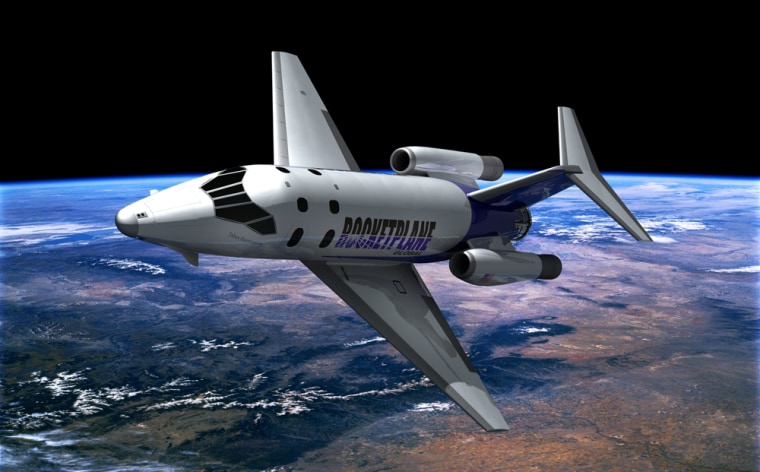Rocketplane Global super-sized its suborbital spaceship on Friday, unveiling an upgraded design that boosts the craft's capacity to five passengers plus a pilot.
The redesigned XP space plane could start flying in 2010, depending on the results of a final round of fundraising, said David Faulkner, program manager for the suborbital project. Friday's announcement represents a shift in emphasis toward suborbital space tourism, in the wake of setbacks suffered by a sister company that focused on orbital launches.
Last week, NASA terminated a multimillion-dollar spaceship development deal with that sister company, Rocketplane Kistler, citing the orbital venture's failure to attract $500 million in outside investment.
Faulkner emphasized that the orbital and suborbital operations were handled by financially separate subsidiaries of Oklahoma-based Rocketplane. "We are a distinct legal company," he told msnbc.com. Nevertheless, the orbital side of the business has been more active over the past year and a half, while the suborbital side seemed relatively quiet. Now the situation is reversed.
Even while Rocketplane Kistler's K-1 orbital launch vehicle took the limelight, engineers on the suborbital development team were quietly analyzing the XP's aerodynamics and found ways to make improvements, Faulkner said.
"To date, we've spent more than 200,000 hours of engineering work on this vehicle," he said.
Leaving the Learjet behind
The main difference is that engineers dropped the idea of retrofitting a commercial Learjet with a rocket. Instead, they redid the design from scratch to make the fuselage 10 percent wider, Faulkner said. That provided enough extra room to add two more seats to the craft's original four-seat configuration — boosting the potential revenue from each flight by more than 60 percent.
"The market's really matured, and we took a hard look at the business plan," Faulkner said. "It made more sense to go with five passengers, and the Lear just wouldn't support that."
Among the other, less noticeable changes: The XP's jet engines would be more powerful — allowing the plane to rise higher, to 40,000 feet, before the Polaris AR-36 rocket engine kicks in with 36,000 pounds of thrust. The V-shaped tailfin is now T-shaped, the main wings have been reworked, and small winglets have been added to enhance stability.
Retired NASA astronaut John Herrington, who is now on Rocketplane Global's payroll and will serve as the XP's first pilot, praised the redesign. "What the engineers have done over the past year and a half speaks volumes," he told msnbc.com. "They're all really smart guys."
Sizing up the space race
Rocketplane Global is competing with Virgin Galactic and other companies to bring paying passengers up to the edge of space.
The company's rocket-jet plane would take off like an airplane from the Oklahoma Spaceport and rise to a height just over 62 miles (100 kilometers). At the top of the ride, customers would feel several precious minutes of weightlessness and see the curving Earth beneath the blackness of space.
The fliers would feel a maximum of 4 G's on the way down, then return to the Oklahoma Spaceport for a runway landing. The price tag? $200,000, with a premium fare of $250,000 charged for riding shotgun alongside the pilot.
George French III, business development associate at Rocketplane, declined to say how many passengers have signed up so far but said the XP was attracting interest from individuals as well as microgravity researchers and corporate clients. (One prominent client is Microsoft, which is a partner in the MSNBC.com joint venture.)
"Our waiting list has been increasing quite a lot over the past six months," French told msnbc.com.
A customer's view
Rocketplane Global's first customer, Reda Anderson, wasn't impressed by the prospect of having four fellow passengers instead of two. "I'd rather it was smaller than bigger," she told msnbc.com.
But she did like what she heard about the interior cabin concept being prepared by Frank Nuovo, an industrial designer who's best-known for his high-end cell phone creations. Nuovo's design features trendy mesh-covered seats, user-controlled video camera systems and a generally swoopy look.
"We're trying to get the race-car, BMW feel, so there's an excitement and a style to the cabin elements," Chuck Lauer, vice president of business development, told msnbc.com.
At one time, Rocketplane's development schedule called for suborbital spaceflights to begin this year, but corporate complications and engineering considerations have led to revisions in the time line.
Faulkner said Rocketplane Global was still seeking its last round of funding, and that financial quest could well determine the future pace of spaceship development. He said the current engineering schedule would allow for test flights to begin in 2010, with commercial service potentially beginning late that year. That timetable would roughly parallel the current expectations for Virgin Galactic and other suborbital space operators.
"Things are taking a little longer," Faulkner said, "but we're going to be right in there with our competitors in 2010."
